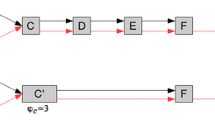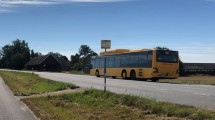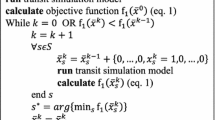Abstract
Pairing, or bunching, of vehicles on a public transportation line influences the adaptive choice at stops due to the random headways and waiting times it determines. In order to ensure consistency with the characteristics of service perturbations, as represented by a transit operation model, it is important to identify the headway distributions representing service perturbations. A stochastic simulation model is developed for a one-way transit line, which accounts for several service characteristics (dwell time at stops, capacity constraint and arrivals during the dwell time). Samples of headways at the main stops are utilized to build histograms of the headway’s frequencies by their length, which allow to identify the functional forms and parameters of the headway distributions. For these stops, density plots of consecutive headways are also produced. Sensitivity analysis is carried out to identify the effect of key parameters (dispatching headway, maximum load and running time).
Similar content being viewed by others
References
Arnold BC, Castillo E, Sarabia JM, Gonzalez-Vega L (2000) Multiple modes in densities with normal conditionals. Stat Probab Lett 49(4):355–363
Bellei G, Gkoumas K (2009) Integrated public transit priority strategies. In: Proceedings of CASPT XI
Bertini RL, El-Geneidy AM (2004) Modeling transit trip time using archived bus dispatch system data. J Transp Eng ASCE 130(1):56–67
Bouzaïene-Ayari B, Gendreau M, Nguyen S (2001) Modeling bus stops in transit networks: A survey and new formulations. Transp Sci 35(3):304–321
Chapman RA, Michel JF (1978) Modelling the tendency of buses to form pairs. Transp Sci 12(2):165–175
Daganzo CF (2009) A headway-based approach to eliminate bus bunching: Systematic analysis and comparisons. Transp Res B 43(10):913–921
Desaulniers G, Hickman MD (2007) Public transit. In: Barnhart C, Laporte G (eds) Handbooks in operations research & management science: Transportation, vol 14. Elsevier, Amsterdam, pp 69–127
Gentile G, Nguyen S, Pallottino S (2005) Route choice on transit networks with online information at stops. Transp Sci 39(3):289–297
Hickman MD (2001) An analytic stochastic model for the transit vehicle holding problem. Transp Sci 35(3):215–237
Larson R, Odoni A (1981) Urban operations research. Prentice Hall, New York
Matsumoto M, Nishimura T (1998) Mersenne twister: A 623-dimensionally equidistributed uniform pseudorandom number generator. Trans Modell Comput Simul 8(1):3–30
Nagatani T (2001a) Bunching transition in a time-headway model of a bus route. Phys Rev E 63(3):36115
Nagatani T (2001b) Interaction between buses and passengers on a bus route. Physica A 296(1):320–330
Nagatani T (2002) Bunching and delay in bus-route system with a couple of recurrent buses. Physica A 305(3):629–639
Newell GF, Potts RB (1964) Maintaining a bus schedule. Proc 2nd Aust Road Res Board Conf 2(1):388–393
Nguyen S, Pallottino S, Gendreau M (1998) Implicit enumeration of hyperpaths in logit models for transit networks. Transp Sci 32(1):54–64
Sarabia JM, Castillo E, Pasqual M, Sarabia M (2007) Bivariate income distributions with lognormal conditionals. J Econ Inequal 5(3):371–383
Spiess H, Florian M (1989) Optimal strategies: A new assignment model for transit networks. Transp Res B 23(2):83–102
Strathman JG, Kimpel TJ, Dueker KJ, Gerhart R, Turner K, Griffin D, Callas S (2001) Bus transit operations control: Review and an experiment involving Tri-Met’s automated bus dispatch system. J Public Transp 4(1):1–26
Sun A, Hickman M (2008) The holding problem at multiple holding stations. In: Hickman M, Mirchandani P, Voss S (eds) Computer-aided systems in public transport. Springer, Berlin, pp 339–362
Turnquist MA, Blume SW (1980) Evaluating potential effectiveness of headway control strategies for transit systems. Transp Res Rec 746:25–29
Vuchic VR (1969) Propagation of schedule disturbances in line-haul passenger transportation. Rev UITP 18(4):281–285
Welding PI (1957) The instability of close interval service. Oper Res Q 8(3):133–148
Wilson NHM, Macchi RA, Fellows RE, Deckoff AA (1992) Improving service on the MBTA green line through better operations control. Transp Res Rec 1361:296–304
Author information
Authors and Affiliations
Corresponding author
Additional information
Prof. Giuseppe Bellei passed away while this paper was under review.
Rights and permissions
About this article
Cite this article
Bellei, G., Gkoumas, K. Transit vehicles’ headway distribution and service irregularity. Public Transp 2, 269–289 (2010). https://doi.org/10.1007/s12469-010-0024-7
Published:
Issue Date:
DOI: https://doi.org/10.1007/s12469-010-0024-7




